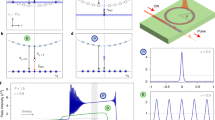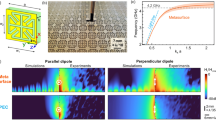Abstract
Surface plasmon polaritons and phonon polaritons offer a means of surpassing the diffraction limit of conventional optics and facilitate efficient energy storage, local field enhancement and highsensitivity sensing, benefiting from their subwavelength confinement of light. Unfortunately, losses severely limit the propagation decay length, thus restricting the practical use of polaritons. While optimizing the fabrication technique can help circumvent the scattering loss of imperfect structures, the intrinsic absorption channel leading to heat production cannot be eliminated. Here, we utilize synthetic optical excitation of complex frequency with virtual gain, synthesized by combining the measurements made at multiple real frequencies, to compensate losses in the propagations of phonon polaritons with dramatically enhanced propagation distance. The concept of synthetic complex frequency excitation represents a viable solution to the loss problem for various applications including photonic circuits, waveguiding and plasmonic/phononic structured illumination microscopy.
This is a preview of subscription content, access via your institution
Access options
Access Nature and 54 other Nature Portfolio journals
Get Nature+, our best-value online-access subscription
$29.99 / 30 days
cancel any time
Subscribe to this journal
Receive 12 print issues and online access
$259.00 per year
only $21.58 per issue
Buy this article
- Purchase on Springer Link
- Instant access to full article PDF
Prices may be subject to local taxes which are calculated during checkout




Similar content being viewed by others
Data availability
The data that support the findings of this study are available within this Article and the Supplementary Information.
Code availability
The code that supports the findings of this study is available from the corresponding author upon reasonable request.
References
Barnes, W. L., Dereux, A. & Ebbesen, T. W. Surface plasmon subwavelength optics. Nature 424, 824–830 (2003).
Oulton, R. F. et al. Plasmon lasers at deep subwavelength scale. Nature 461, 629–632 (2009).
Gramotnev, D. K. & Bozhevolnyi, S. I. Plasmonics beyond the diffraction limit. Nat. Photon. 4, 83–91 (2010).
Basov, D. N., Fogler, M. M. & García De Abajo, F. J. Polaritons in van der Waals materials. Science 354, aag1992 (2016).
Low, T. et al. Polaritons in layered two-dimensional materials. Nat. Mater. 16, 182–194 (2017).
Wei, H., Wang, Z., Tian, X., Käll, M. & Xu, H. Cascaded logic gates in nanophotonic plasmon networks. Nat. Commun. 2, 387 (2011).
Fu, Y. et al. All-optical logic gates based on nanoscale plasmonic slot waveguides. Nano Lett. 12, 5784–5790 (2012).
Zhang, Q. et al. Interface nano-optics with van der Waals polaritons. Nature 597, 187–195 (2021).
Stockman, M. I. Nanofocusing of optical energy in tapered plasmonic waveguides. Phys. Rev. Lett. 93, 137404 (2004).
Prodan, E., Radloff, C., Halas, N. J. & Nordlander, P. A hybridization model for the plasmon response of complex nanostructures. Science 302, 419–422 (2003).
Woessner, A. et al. Highly confined low-loss plasmons in graphene–boron nitride heterostructures. Nat. Mater. 14, 421–425 (2015).
Arakawa, E. T., Williams, M. W., Hamm, R. N. & Ritchie, R. H. Effect of damping on surface plasmon dispersion. Phys. Rev. Lett. 31, 1127–1129 (1973).
Bozhevolnyi, S. I., Volkov, V. S., Devaux, E., Laluet, J.-Y. & Ebbesen, T. W. Channel plasmon subwavelength waveguide components including interferometers and ring resonators. Nature 440, 508–511 (2006).
Anker, J. N. et al. Biosensing with plasmonic nanosensors. Nat. Mater. 7, 442–453 (2008).
Rodrigo, D. et al. Mid-infrared plasmonic biosensing with graphene. Science 349, 165–168 (2015).
Yang, X. et al. Nanomaterial-based plasmon-enhanced infrared spectroscopy. Adv. Mater. 30, 1704896 (2018).
Bylinkin, A. et al. Real-space observation of vibrational strong coupling between propagating phonon polaritons and organic molecules. Nat. Photon. 15, 197–202 (2021).
Fang, N., Lee, H., Sun, C. & Zhang, X. Sub-diffraction-limited optical imaging with a silver superlens. Science 308, 534–538 (2005).
Liu, Z., Lee, H., Xiong, Y., Sun, C. & Zhang, X. Far-field optical hyperlens magnifying sub-diffraction-limited objects. Science 315, 1686 (2007).
Li, P. et al. Hyperbolic phonon-polaritons in boron nitride for near-field optical imaging and focusing. Nat. Commun. 6, 7507 (2015).
Dai, S. et al. Subdiffractional focusing and guiding of polaritonic rays in a natural hyperbolic material. Nat. Commun. 6, 6963 (2015).
Wei, F. & Liu, Z. Plasmonic structured illumination microscopy. Nano Lett. 10, 2531–2536 (2010).
Yan, H. et al. Damping pathways of mid-infrared plasmons in graphene nanostructures. Nat. Photon. 7, 394–399 (2013).
Ni, G. X. et al. Fundamental limits to graphene plasmonics. Nature 557, 530–533 (2018).
Anantha Ramakrishna, S. & Pendry, J. B. Removal of absorption and increase in resolution in a near-field lens via optical gain. Phys. Rev. B 67, 201101 (2003).
Xiao, S. et al. Loss-free and active optical negative-index metamaterials. Nature 466, 735–738 (2010).
Hess, O. et al. Active nanoplasmonic metamaterials. Nat. Mater. 11, 573–584 (2012).
Stockman, M. I. Spaser action, loss compensation, and stability in plasmonic systems with gain. Phys. Rev. Lett. 106, 156802 (2011).
Pendry, J. B. & Maier, S. A. Comment on ‘Spaser action, loss compensation, and stability in plasmonic systems with gain’. Phys. Rev. Lett. 107, 259703 (2011).
Wuestner, S., Pusch, A., Tsakmakidis, K. L., Hamm, J. M. & Hess, O. Comment on ‘Spaser action, loss compensation, and stability in plasmonic systems with gain’. Phys. Rev. Lett. 107, 259701 (2011).
Archambault, A., Besbes, M. & Greffet, J. J. Superlens in the time domain. Phys. Rev. Lett. 109, 097405 (2012).
Guan, F. et al. Overcoming losses in superlenses with synthetic waves of complex frequency. Science 771, 766–771 (2023).
Kim, S., Peng, Y., Yves, S. & Alù, A. Loss compensation and super-resolution with excitations at complex frequencies. Phys. Rev. X 13, 041024 (2023).
Tetikol, H. S. & Aksun, M. I. Enhancement of resolution and propagation length by sources with temporal decay in plasmonic devices. Plasmonics 15, 2137–2146 (2020).
Kirby, E. I., Hamm, J. M., Pickering, T. W., Tsakmakidis, K. L. & Hess, O. Evanescent gain for slow and stopped light in negative refractive index heterostructures. Phys. Rev. B 84, 041103 (2011).
Ciattoni, A., Marini, A., Rizza, C., Scalora, M. & Biancalana, F. Polariton excitation in epsilon-near-zero slabs: transient trapping of slow light. Phys. Rev. A 87, 053853 (2013).
Tsakmakidis, K. L., Pickering, T. W., Hamm, J. M., Page, A. F. & Hess, O. Completely stopped and dispersionless light in plasmonic waveguides. Phys. Rev. Lett. 112, 167401 (2014).
Tsakmakidis, K. L., Baskourelos, K. G. & Wartak, M. S. Metamaterials and Nanophotonics (World Scientific, 2022).
Baranov, D. G., Krasnok, A. & Alù, A. Coherent virtual absorption based on complex zero excitation for ideal light capturing. Optica 4, 1457–1461 (2017).
Kim, S., Lepeshov, S., Krasnok, A. & Alù, A. Beyond bounds on light scattering with complex frequency excitations. Phys. Rev. Lett. 129, 203601 (2022).
Li, H., Mekawy, A., Krasnok, A. & Alù, A. Virtual parity-time symmetry. Phys. Rev. Lett. 124, 193901 (2020).
Gu, Z. et al. Transient non-Hermitian skin effect. Nat. Commun. 13, 7668 (2022).
Li, N. et al. Direct observation of highly confined phonon polaritons in suspended monolayer hexagonal boron nitride. Nat. Mater. 20, 43–48 (2021).
Dai, S. et al. Tunable phonon polaritons in atomically thin van der Waals crystals of boron nitride. Science 343, 1125–1130 (2014).
Yoxall, E. et al. Direct observation of ultraslow hyperbolic polariton propagation with negative phase velocity. Nat. Photon. 9, 674–678 (2015).
Kurman, Y. et al. Spatiotemporal imaging of 2D polariton wave packet dynamics using free electrons. Science 372, 1181–1186 (2021).
Guo, X. et al. Hyperbolic whispering-gallery phonon polaritons in boron nitride nanotubes. Nat. Nanotechnol. 18, 529–534 (2023).
Zheng, Z. et al. Highly confined and tunable hyperbolic phonon polaritons in van der Waals semiconducting transition metal oxides. Adv. Mater. 30, 1705318 (2018).
Hu, G. et al. Topological polaritons and photonic magic angles in twisted α-MoO3 bilayers. Nature 582, 209–213 (2020).
Ma, W. et al. In-plane anisotropic and ultra-low-loss polaritons in a natural van der Waals crystal. Nature 562, 557–562 (2018).
Guo, X. et al. Mid-infrared analogue polaritonic reversed Cherenkov radiation in natural anisotropic crystals. Nat. Commun. 14, 2532 (2023).
Wang, M. et al. Spin–orbit-locked hyperbolic polariton vortices carrying reconfigurable topological charges. eLight 2, 12 (2022).
Hu, C. et al. Source-configured symmetry-broken hyperbolic polaritons. eLight 3, 14 (2023).
Huang, W. et al. In-plane hyperbolic polariton tuners in terahertz and long-wave infrared regimes. Nat. Commun. 14, 2716 (2023).
Acknowledgements
This work was supported by New Cornerstone Science Foundation and the Research Grants Council of Hong Kong, AoE/P-701/20, 17315522, A-HKU705/21 (to Shuang Zhang), the National Natural Science Foundation of China (51925203 to Q.D.; 52022025 to X.Y. and 52102160 to X.G.) and the Young Elite Scientists Sponsorship Program by CAST, 2022QNRC001 (to X.G.).
Author information
Authors and Affiliations
Contributions
Shuang Zhang, F.G., Q.D. and X.G. conceived the project. F.G. and X.G. designed the experiments. X.G. and Shu Zhang prepared the experimental samples and performed the s-SNOM experiments with the help of C.W.; F.G. and X.G. analysed the experimental data and performed the simulation. F.G., X.G., Shu Zhang, K.Z., Y.H., Y.X., S. Zhou, X.Y., Q.D. and Shuang Zhang participated in the analysis of the results. F.G., X.G. and Shuang Zhang wrote the manuscript with input from all authors. Shuang Zhang and Q.D. supervised the overall projects. All authors contributed to the discussion.
Corresponding authors
Ethics declarations
Competing interests
The authors declare no competing interests.
Peer review
Peer review information
Nature Materials thanks the anonymous reviewers for their contribution to the peer review of this work.
Additional information
Publisher’s note Springer Nature remains neutral with regard to jurisdictional claims in published maps and institutional affiliations.
Supplementary information
Supplementary Information
Supplementary Sections 1–4 and Figs. 1–11.
Supplementary Video 1
Wave propagation video.
Supplementary Video 2
Wave propagation video.
Rights and permissions
Springer Nature or its licensor (e.g. a society or other partner) holds exclusive rights to this article under a publishing agreement with the author(s) or other rightsholder(s); author self-archiving of the accepted manuscript version of this article is solely governed by the terms of such publishing agreement and applicable law.
About this article
Cite this article
Guan, F., Guo, X., Zhang, S. et al. Compensating losses in polariton propagation with synthesized complex frequency excitation. Nat. Mater. 23, 506–511 (2024). https://doi.org/10.1038/s41563-023-01787-8
Received:
Accepted:
Published:
Issue Date:
DOI: https://doi.org/10.1038/s41563-023-01787-8
This article is cited by
-
Complex-frequency waves: beat loss and win sensitivity
Light: Science & Applications (2024)
-
“The unreasonable effectiveness of mathematics” in evading polaritonic losses
Nature Materials (2024)



